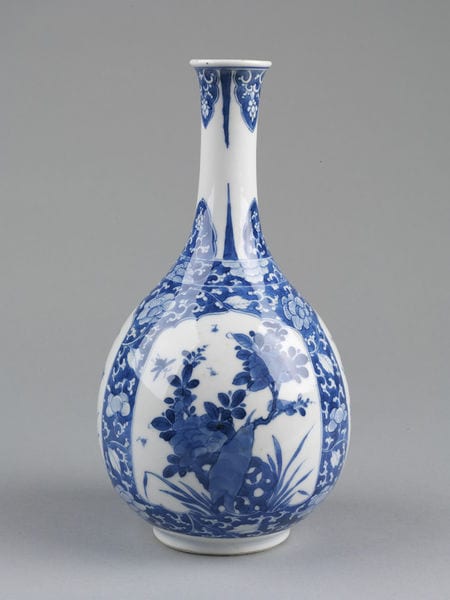Women, porcelain and pleasure
During the eighteenth century porcelain remained synonymous with women. As Elizabeth Kowaleski-Wallace argues, throughout the period, a variety of authors wrote of fine china or porcelain to denote women and their weaknesses.[1] China and porcelain ‘made it possible for people to talk about women and their qualities in a particular way.’[2] Scholars such as David Porter assert that porcelain was significant in providing a space in which different ideas about women, desire, sensuality, novelty, temptation and exchange could come together, ‘giving form through its very materiality to fears and pleasures which, in the absence of a suitable substitute, might otherwise have remained hauntingly inchoate.’[3]

Figure 3. Vase. Porcelain painted in underglazed blue. Jingdezhen, China. 1700-10. C.712-1910. © Victoria and Albert Museum, London.
In the early decades of the eighteenth century, for example, writers such as Alexander Pope and Joseph Addison used ‘china’ as means through which to discuss female sexuality, desire and subjectivity. In these texts, authors frequently conflated women’s bodies with the material qualities of porcelain. Delicate, translucent, fragile and breakable – porcelain could be equated with characteristics that increasingly came to define a specific view of femininity. Here women came under the male and female gaze as objects of desire. Kowaleski-Wallace argues, however, that what was principally at stake in these discussions was not women as objects of desire, but rather the issue of female desire itself.[4] Chinese porcelain provided an acceptable space in which to discuss worries that women possessed and expressed tangible desires of their own. More worryingly still they engaged with the market in order to satisfy those desires, supposedly buying up porcelain in their droves.
Elizabeth Chang notes that discussions regarding women and porcelain must also be understood in class terms. She asserts that ‘only wealthier kinds of women were held to possess the leisure necessary to build an impressive collection of imported porcelain’.[5] Nevertheless, women from the genteel and middling classes also actively engaged in and took pleasure from purchases of china.[6] In representations depicting the relationship between women and Chinese porcelain then, commentators gestured towards the threatening nature of class mobility implied by middling women purchasing and owning these wares.[7] Importantly, it must also be remembered that over the course of the eighteenth century, renderings of women and their relationship to and with porcelain steadily shifted. Porter understands these shifts as undergoing three stages. First, in the early decades of the eighteenth century, women were particularly linked to porcelain in terms of commoditized desire.[8] Women were frequently portrayed as entering the marketplace to purchase or view porcelain goods at all costs, and such representations often eroticized such desires, understanding them as unbridled passions and lusts. Second, porcelain came to be increasingly portrayed within domestic settings. Here, porcelain was often linked to subversive female agency. While painters such as Hogarth used broken jars to signify illicit liaisons and sexual acts, painters could also highlight female resistance and subversion by showing thrown and broken ceramics.[9] Finally at the turn of the nineteenth century, ceramics brokered women’s submersion in domestic and maternal roles. Here, women were shown lovingly pouring tea from teapots to signify both matriarchal control and love.[10]
If then, as scholars such as David Porter and Elizabeth Kowaleski-Wallace suggest, Chinese porcelain (and other forms of ceramic ware) were consistently linked to women in the eighteenth century, how can we begin to understand the relationship between men and porcelain wares? More particularly what was armorial Chinese porcelain and how was it understood within this culture? Three key avenues of enquiry can be used to consider these questions – acquisition, design and use. By examining the modes by which armorial porcelains were purchased, the designs with which they were decorated and the way in which they were used, this study suggests that armorial wares were distinctly male – carrying a different set of connotations and meanings to other porcelain pieces.
[1]Kowaleski-Wallace, Consuming Subjects, p. 53. Also see Porter, The Chinese Taste in Eighteenth-Century England, p. 141.
[2] Kowaleski-Wallace, Consuming Subjects, p. 53.
[3] Porter, The Chinese Taste in Eighteenth-Century England, p. 139.
[4] Kowaleski-Wallace, Consuming Subjects, p. 56.
[5] Elizabeth Hope Chang, Britain’s Chinese Eye: Literature, Empire and Aesthetics in Nineteenth-Century Britain (Stanford, CA: Stanford University Press, 2010), p. 75.
[6]Amanda Vickery, The Gentleman’s Daughter: Women’s Lives in Georgian England [1998] (New Haven and London: Yale University Press, 2003), p. 169.
[7]Hence women of middling or low social status who desired porcelain wares were critiqued for spending precious family money in the pursuit of personal desire. See for example John Gay, ‘To a Lady on Her Passion for Old China’ (1725).
[8]Porter, The Chinese Taste in Eighteenth-Century England, p. 136.
[9]Ibid., p. 143.
[10]Ibid., p. 149.